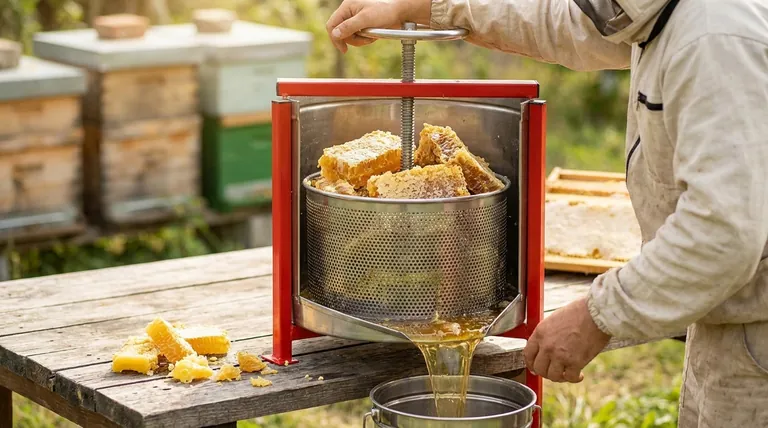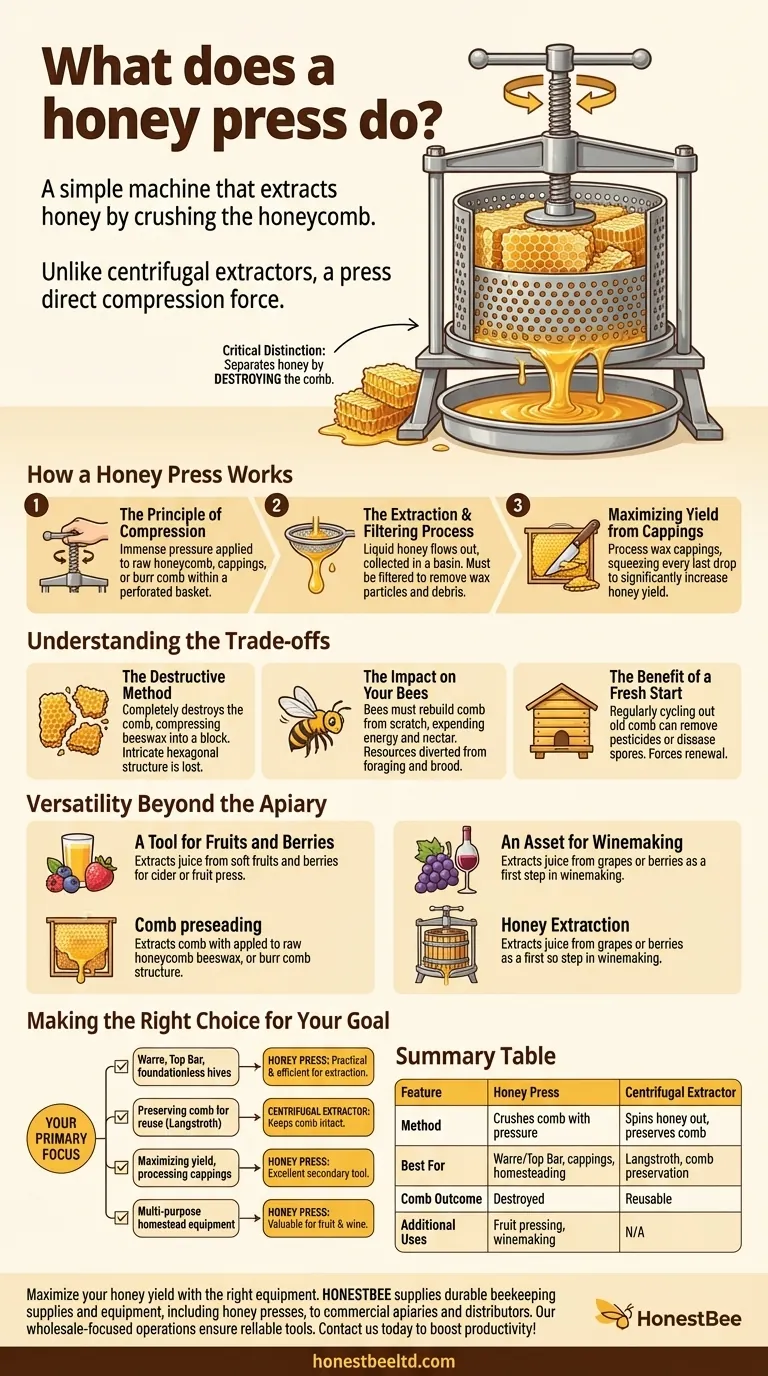In essence, a honey press is a simple machine that extracts honey by crushing the honeycomb. Unlike centrifugal extractors that spin honey out of the comb, a press uses direct compression force to squeeze the honey from the wax. This method is particularly useful for beekeepers with specific hive types, like Warre or Top Bar hives, or for processing wax cappings.
The critical distinction to understand is that a honey press separates honey from wax by destroying the comb. This makes it fundamentally different from a honey extractor, which is designed to preserve the comb for the bees to reuse.

How a Honey Press Works
A honey press, sometimes called a comb crusher, operates on a straightforward mechanical principle. It provides an efficient way to handle comb that isn't suitable for a standard centrifugal extractor.
The Principle of Compression
The core of the process is applying immense pressure. Raw honeycomb, including wax cappings or pieces of burr comb, is placed inside a perforated basket or container within the press.
A press plate is then lowered, typically by turning a large screw handle, which compacts the comb and wax. This force crushes the individual wax cells, releasing the honey.
The Extraction and Filtering Process
As the comb is crushed, the liquid honey flows out through the perforations in the basket and is collected in a basin below. The remaining compressed beeswax is left behind.
The extracted honey will contain particles of wax and other debris. It must be filtered through a fine mesh or cheesecloth to produce the clean, clear honey ready for bottling.
Maximizing Yield from Cappings
One of the most common uses for a honey press is processing wax cappings. These are the thin wax lids that bees build over cells of cured honey, which must be sliced off before extraction.
These cappings are rich with trapped honey. A press allows a beekeeper to squeeze every last drop from this wax, significantly increasing the overall honey yield from a harvest.
Understanding the Trade-offs
Choosing a honey press involves a significant trade-off centered entirely on the fate of the beeswax comb. Understanding this is crucial to deciding if it's the right tool for your apiary.
The Destructive Method
The primary consequence of using a press is that it completely destroys the comb. The beeswax is compressed into a block, and the intricate hexagonal structure the bees worked so hard to build is lost.
The Impact on Your Bees
Bees expend a tremendous amount of energy and consume significant amounts of nectar to produce wax and draw it into comb. By destroying the comb, you require the colony to dedicate resources to rebuilding it from scratch, which could have otherwise been used for foraging or raising brood.
The Benefit of a Fresh Start
Conversely, destroying old comb isn't always a negative. Regularly cycling out old comb can be a healthy practice for a hive, as it removes potential accumulations of pesticides or disease spores. A press ensures you are forcing this renewal.
Versatility Beyond the Apiary
One of the most compelling advantages of a honey press is its usefulness for other agricultural tasks, making it a sound investment for a small farm or homestead.
A Tool for Fruits and Berries
The same mechanism used to press honey from comb is perfectly suited for extracting juice from soft fruits and berries. It can function as an effective fruit or cider press.
An Asset for Winemaking
Similarly, aspiring vintners can use a honey press to extract juice from grapes or other berries as a first step in the winemaking process. This dual-purpose nature adds significant value to the equipment.
Making the Right Choice for Your Goal
The decision between a press and an extractor depends entirely on your hive type, goals, and operational scale.
- If your primary focus is working with Warre, Top Bar, or foundationless hives: A honey press is often the most practical and efficient tool for extraction.
- If your primary focus is preserving comb for reuse in standard Langstroth hives: A centrifugal honey extractor is the correct choice, as it keeps the comb intact.
- If your primary focus is maximizing honey yield and you need a tool for processing cappings: A press is an excellent secondary tool to complement a main extractor.
- If your primary focus is investing in multi-purpose equipment for a small homestead: The versatility of a honey press for fruit and wine makes it an extremely valuable choice.
Ultimately, a honey press is a simple, effective, and often affordable tool designed for a specific method of beekeeping that prioritizes resourcefulness over comb preservation.
Summary Table:
| Feature | Honey Press | Centrifugal Extractor |
|---|---|---|
| Method | Crushes comb with pressure | Spins honey out, preserves comb |
| Best For | Warre/Top Bar hives, cappings, homesteading | Langstroth hives, comb preservation |
| Comb Outcome | Destroyed | Reusable |
| Additional Uses | Fruit pressing, winemaking | N/A |
Maximize your honey yield with the right equipment. HONESTBEE supplies durable beekeeping supplies and equipment, including honey presses, to commercial apiaries and distributors. Our wholesale-focused operations ensure you get reliable tools for efficient harvesting. Contact us today to discuss your needs and boost your operation's productivity!
Visual Guide

Related Products
- 6 Frame Manual Stainless Steel Honey Extractor Beekeeping Equipment
- HONESTBEE 72 Frame Industrial Electric Honey Extractor for Beekeeping
- 8-Frame Electric Self-Reversing Honey Extractor Spinner for Commercial Honey Extraction Equipment
- Plastic Hand Crank 2 Frame Honey Extractor Low Price
- Professional Thermostatic Conical Honey Melter
People Also Ask
- What is the basic principle of the honey extractor? Harness Centrifugal Force for Efficient Harvesting
- What tips can maximize honey extraction efficiency? Unlock Higher Yields and Purer Honey
- Which type of extractor is more suitable for hobbyists or small-scale beekeepers? Find the Perfect Fit for Your Apiary
- How long does it take to extract honey with an extractor? Plan Your Harvest for Maximum Efficiency
- How many frames can different types of honey extractors hold? Maximize Your Harvest Efficiency



















